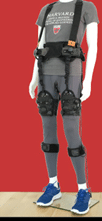Freezing of gait (FOG) is an abnormal gait pattern that can accompany Parkinson’s disease (PD) as well as other parkinsonian disorders in which there are sudden, short, and temporary episodes of an inability to move the feet forward despite the intention to walk. These episodes can significantly interfere in daily life and can result in falls.
Treatments for FOG are not always adequate. Often, medications like levodopa improve FOG, but for some people, increasing medication does not help. Deep brain stimulation may also help some, but not others. Cueing, or the introduction of an external sensory stimulus to facilitate movement, has been identified as a way to “break” a freezing episode. The cue could be walking to a rhythm or stepping over a line on the floor. These techniques can be very helpful, but the need to implement them frequently can be cumbersome during daily life.
Because the current solutions are not adequate for everyone, many people with FOG continue to search for solutions. A recent paper demonstrated an exciting new approach – the use of soft robotic apparel, worn around the waist and thighs, which helps to flex the hips during walking and dramatically improved FOG in an individual with PD.
Terry Ellis, PT, PhD, FAPTA, a member of APDA’s Scientific Advisory Board and Director of the APDA’s National Rehabilitation Resource Center was one of the authors.

The person with PD who was the subject of investigation was on an optimized medication regimen, had undergone deep brain stimulation, and was able to implement cueing strategies as needed, but despite these efforts, had significant amounts of FOG with daily falls. While utilizing the apparatus, he had a remarkable response, decreasing his FOG during indoor walking from about 30% of his walking time to close to 0% of his walking time. Multiple measures of gait, including stride length and foot clearance improved as well.
The device was tried during outside walking as well, which is inherently more challenging because it is less controlled. In this situation, FOG decreased from 63% of the time to 6% of the time.
When asked about her work, Dr. Ellis stated: “Our soft robotic apparel resulted in immediate prevention of freezing of gait with just a small amount of mechanical force to assist with taking a step in an individual with PD and severe freezing of gait. Based on these early results, we are very optimistic about the potential for our robotic apparel to prevent freezing of gait in other people with PD. More testing is necessary to examine the effects of our soft robotic apparel across a range of disease severities and contexts (e.g., indoors, outdoors, turning, through doorways). This approach provides a promising treatment that many people with PD could benefit from in the future. “
Whether this device’s benefits will be as robust in other people with PD remains to be seen. The paper states that multiple experimental variables utilizing the device could potentially be adjusted to serve different people with PD and these will need to be tested in clinical trials as well. In addition, the device itself is complex and may be challenging to get on and off without help, which may limit its usability in the community. Although more work is necessary, this apparatus represents a remarkable proof of concept that brings hope to those with FOG.
